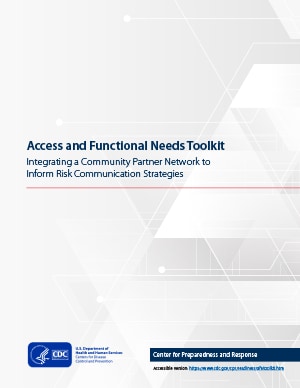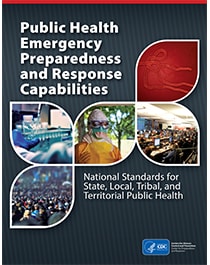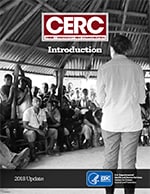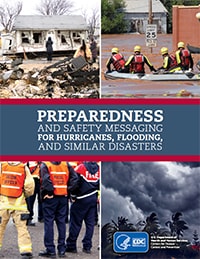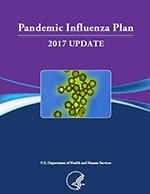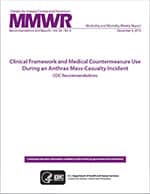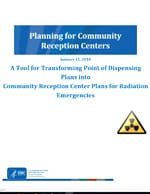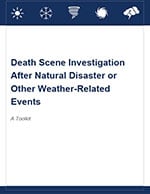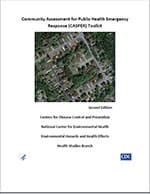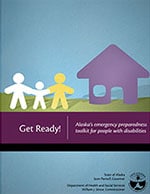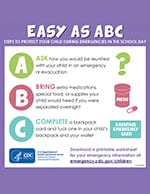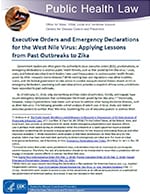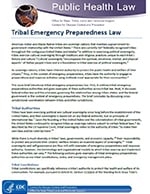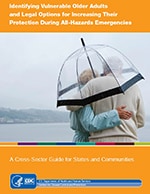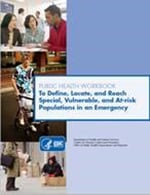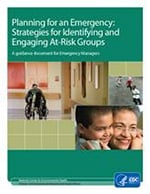Public Health Preparedness Resources
CDC offers resources to assist health departments with their strategic planning to strengthen their public health preparedness capabilities.
The Access and Functional Needs Toolkit can help emergency planners achieve effective communications through the integration of a community outreach information network. The toolkit provides a framework to organize planning for broad groups of people with disabilities and others with access and functional needs, recommended action steps, and noteworthy practices from the field.
CDC’s Public Health Emergency Preparedness and Response Capabilities: National Standards for State, Local, Tribal, and Territorial Public Health is a guide that state and local jurisdictions can use to better organize their work, plan their priorities, and decide which capabilities they have the resources to build or sustain. The capabilities also help ensure that federal preparedness funds are directed to priority areas within individual jurisdictions.
CDC offers a variety of resources for emergency health professionals including clinicians, communicators, laboratorians, emergency planners and responders, and disaster relief volunteers to prepare them to respond to a public health emergency.
The Preparedness and Safety Messaging for Hurricanes, Flooding, and Similar Disasters can help local responders quickly create and adapt health communication products for affected communities. The document contains messages on various topics including food safety, carbon monoxide poisoning, waterborne diseases, and mold.
Although pandemics occur infrequently, planning and preparing for a pandemic is important to ensure an effective response. The Influenza Planning and Preparedness Resources webpage offers tools to help state, local, tribal, and territorial health officials prepare for the next influenza pandemic.
The Anthrax Healthcare Providers webpage provides tools and resources to help state, local, tribal, and territorial health officials plan and prepare for an anthrax attack.
The Radiation Emergency Training, Education, and Tools webpage provides resources to help state, local, tribal, and territorial health officials plan and prepare for a radiation emergency. Resources include the Planning for Community Reception Centers tool, the CRC Electronic Data Collection Tool (CRC eTool), the Radiation Hazard Scale, and the Medical Countermeasures for Radiation Exposure and Contamination training.
The Public Health Surveillance during a Disaster webpage provides morbidity and mortality surveillance tools and training materials for state, local, tribal, and territorial health officials, including the Death Scene Investigation Toolkit, Reference Guide for Death Certification, Disaster-Related Mortality Surveillance Form
The Community Assessment for Public Health Emergency Response (CASPER) is an epidemiologic technique designed to provide quickly and at low-cost household based information about a community. The CASPER toolkit can assist local, state, regional, or federal officials conduct a rapid needs assessment to determine the health status, basic needs, or knowledge, attitudes, and practices of a community in a quick and low-cost manner.
Emergencies and disasters can strike quickly and without warning, forcing people to quickly leave or be confined in their home unexpectedly. The Emergency Preparedness: Including People with Disabilities webpage offers resources that public health professionals, emergency personnel and communities can use to create emergency preparedness and response plans that are inclusive of people with disabilities.
Disasters affect children differently than they do adults. The Caring for Children in a Disaster webpage provides tools and resources that public health professionals, emergency personnel and communities can use to protect children during and after an emergency.
The Public Health Emergency Preparedness Clearinghouse is a central repository for emergency preparedness-related statutes, regulations, orders, reports, and legal tools. The Clearinghouse is intended to aid jurisdictions considering updates and clarifications to their public health emergency legal preparedness activities.
Effective emergency preparedness planning, response, and recovery in tribal communities includes consideration of the unique cultural and traditional needs of those communities. The tribal support webpage provides information for tribal governments and their partners to serve tribal communities more effectively. These resources also provide information to help community members plan for emergencies and apply for assistance when disaster strikes.
Identifying Vulnerable Older Adults and Legal Options for Increasing Their Protection During All-Hazards Emergencies: A Cross-Sector Guide for States and Communities aims to equip public health officials, the aging services network, emergency management, and essential partners from other sectors and at all jurisdictional levels with critical information, strategies, and resources to improve the planning for and protection of vulnerable community-dwelling older adults during all-hazards public health emergencies. The guide covers topic areas such as developing plans, partnering and collaboration, using data for action, building registries, using law-based solutions, sheltering, and caregiver preparedness.
Public Health Workbook to Define, Locate and Reach Special, Vulnerable, and At-Risk Populations in an Emergency provide public health officials information for identifying at-risk groups and developing Community Outreach Information Networks (COINs).
Planning for an Emergency: Strategies for Identifying and Engaging At-Risk Groups provides examples of approaches and tools approaches and tools that can help emergency managers identify, plan for, and assist at-risk populations.
Additional resources are available in CDC’s Online Technical Resource and Assistance Center.
